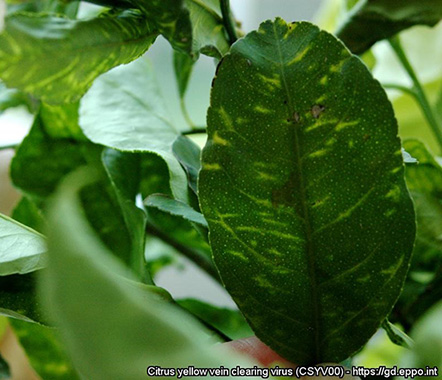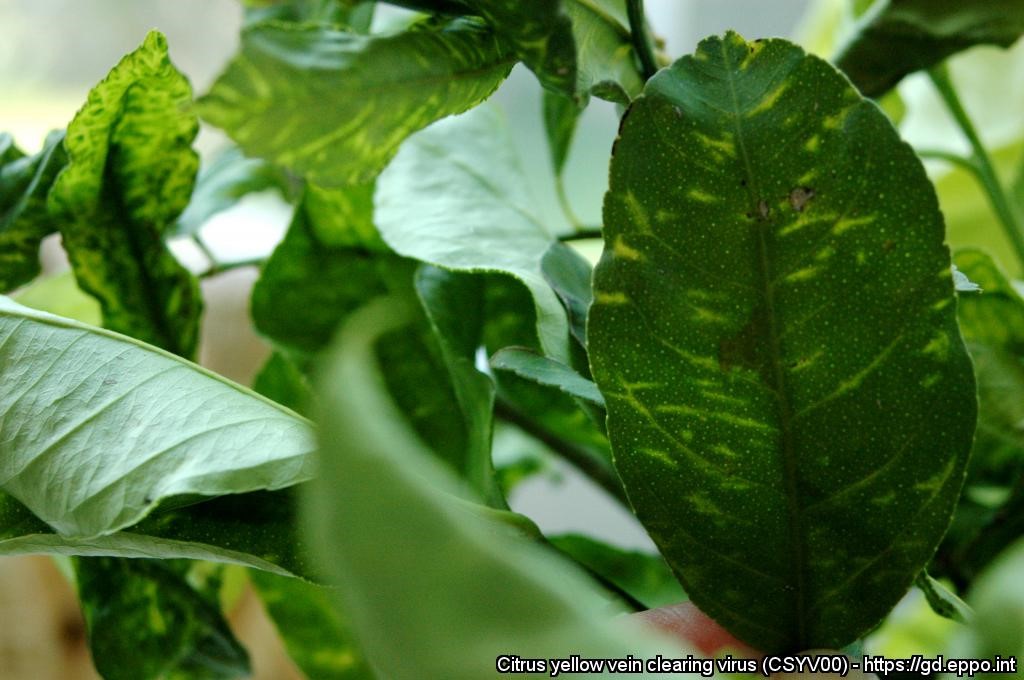Citrus Yellow Vein Clearing Virus Pest Profile
Pest Profile

Description
Citrus yellow vein clearing virus (CYVCV) is an emerging disease of citrus that can lead to significant economic losses to the industry. CYVCV can cause serious damage to most citrus species and can dramatically diminish fruit marketability (Liu et al, 2020).
CYVCV is transmitted by aphids including Aphis spiraecola Patch, Aphis craccivora Koch, and a whitefly Dialeurodes citri. All three of these insects are present and widespread in California. Melon aphid, Aphis gossypii, a C-rated and common pest in California, is also a vector of CYVCV. CYVCV has not been shown to be transmitted through contaminated seeds, yet the virus can be detected in seed tissue. The most prominent mechanism for long-distance spread of CYVCV is caused by grafting infected budwood. CYVCV is a single stranded positive sense ribonucleic acid virus and mostly found in the phloem. It is closely related to Indian citrus ringspot virus.
History
CYVCV was first discovered in 1988 on lemon and sour orange trees in Pakistan. In 1997, CYVCV symptoms were observed on other lemon cultivars, limes, and sour oranges in several regions of India. In 2000, the disease was then observed in Turkey. In 2009, trees with CYVCV symptoms were detected in Yunnan, China, which later spread to multiple other Chinese citrus-growing regions (Loconsole et al., 2012).
Distribution
CYVCV is currently restricted to Pakistan, India, China, Iran, and Turkey. CYVCV is distributed in nearly all citrus-producing areas of China and is spreading rapidly (Liu et al., 2020).
Symptoms
Symptom expression is dependent on the citrus variety, viral strain, and environmental conditions, especially temperature. The leaves of young lemon and sour orange trees display a water-soaked appearance and yellow, clear veins on their front side, and wrinkled and warped leaves. Some symptoms of infected trees are more diverse, with irregular ringspots on leaves, and mosaic-like patterns on citrus fruits. Symptoms of lemon or sour orange trees infected with CYVCV are less pronounced in summer. CYVCV can also be asymptomatic on some citrus cultivars. Under severe conditions, virus-infected trees die-back and fruits are malformed, causing reduced quality.

(Photo credit: https://gd.eppo.int/taxon/CSYV00/photos)

(Photo credit: YU, et al, 2017.)
Hosts
CYVCV can infect most citrus species, cultivars, and hybrids, particularly lemon and sour orange. CYVCV can be transmitted to some non-citrus hosts including herbaceous plants where it can cause chlorosis, mosaic like patterns of leaves, and general necrosis (Liu et al, 2020). Additionally, CYVCV has been detected in weed species, but the infected plants are mostly asymptomatic (Onelge et al.,2016). In 2020, CYVCV was reported to also infect grapevines (Afloukou and Önelge, 2020).
Damage and Economic Importance
CYVCV is an emerging disease causing escalating economic losses in multiple citrus species and varieties, especially lemons. The disease appears to be spreading rapidly in Asia with infected budwood, mechanical inoculation into different plant species, and with sap feeding insect vectors. It can severely affect tree growth and fruit yield. There is also potential to cause damage to grapevines. Three of the known vectors (spirea aphid, cowpea aphid, and citrus whitefly) are already widespread in California. CYVCV is frequently asymptomatic in most sweet orange, pummelo, tangerine, and mandarin varieties, and propagation of asymptomatic but infected plant material can exacerbate the distribution of CYVCV. This is a disease of quarantine significance to the United States.
References
- Afloukou, F. M., & Önelge, N. (2020). First report of natural infection of grapevine (Vitis vinifera) by Citrus yellow vein clearing virus. New Disease Reports, 42(1), 5-5.
- Liu, C., Liu, H., Hurst, J., Timko, M. P., & Zhou, C. (2020). Recent Advances on Citrus yellow vein clearing virus in Citrus. Horticultural Plant Journal, 6(4), 216-222.
- Loconsole, G., Önelge, N., Potere, O., Giampetruzzi, A., Bozan, O. R. H. A. N., Satar, S. E. R. D. A. R., ... & Saponari, M. (2012). Identification and characterization of Citrus yellow vein clearing virus, a putative new member of the genus Mandarivirus. Phytopathology, 102(12), 1168-1175.
- Önelge, N., Bozan, O., & Gök-Güler, P. (2016). First report of Citrus yellow vein clearing virus infecting new natural host plants in Turkey. Journal of Plant Pathology, 98(2).
- YU, Y. Q., Qiong, W. U., SU, H. N., WANG, X. F., CAO, M. J., & ZHOU, C. Y. (2017). Small RNA deep sequencing reveals full-length genome of Citrus yellow vein clearing virus in Chongqing, China. Journal of integrative agriculture, 16(2), 503-508.
- https://pubag.nal.usda.gov/catalog/7298140
